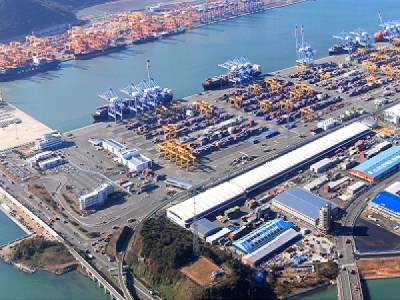
Posted on August 4, 2016
By Dave MacIntyre, portstrategy
Busan Port Authority (BPA) has a firm goal to develop Busan into a global hub and the largest transhipment port in Asia.
The port, located on the south-eastern tip of the Korean peninsula, is adjacent to South Korea’s second largest city after Seoul and serves the country’s largest industrial area, the South East Economic Zone.
Beyond its importance to the domestic Korean economy, Busan has major importance in the Asian transhipment ports network, and that importance is growing year-on-year.
Container traffic is the main focus of the port, says Jinsun Shin, head of the Euro Representative Office of the BPA. “More than 97% of cargo handled at Busan Port is containers. In 2016, even though the shipping market has been in a downturn, we targeted to handle 20m teu.
“However, as the global trade has been sluggish and world major ports have witnessed negative growth this year, I believe it would be quite hard for Busan to meet the target.”
Even if it fails to do so, Busan’s growth record is impressive. Container throughput has risen from 14.19m teu in 2010 to 19.46m teu in 2015. Of this, local domestic traffic has risen from 7.8m teu to 9.36m teu.
Of greater impact has been the increase in the importance of transhipped cargo, which at 6.27m teu represented 44.2% of container throughput in 2010 but last year reached 10.10m teu – 52% of the total.
This underlines the hub port focus that Busan is bringing to its planning, aiming to accommodate the largest of boxships. The port is already reacting to the trend towards bigger ships being deployed of 18,000 teu and more with an active dredging and investment programme.
“As the ships are getting bigger and bigger, in order to accommodate these big vessels, the BPA is dredging the New Port to 17 metres by the end of 2016,” says Jinsun Shin.
“Also, there exists an island, Todo Island, in the entrance of Busan New Port. As of now, the government and the BPA have been doing various studies – environmental impact, navigational impact and others – to remove the island.”
Infrastructure
The port has quays ranging in length to two kilometres with up to 18 metres depth alongside. All but one of the berths is 15 metres deep or more. The biggest ships being operated by Maersk and MSC have already called at Busan.
BPA is now seeking to further strengthen the competiveness of Busan through a programme of terminal integration at Busan North Port and additional terminal construction in Busan New Port.
At North Port, the specialist intra-Asian transhipment hub function will be maintained. Four terminal operators – Hutchison, Gamman, Singamman and Sinsundae – have signed a memorandum of understanding to allow terminal integration to proceed.
At Busan New Port, a total of 45 berths are planned, and the removal of Todo Island is slated for 2019.
As a further string to its bow, BPA is looking to diversify its portfolio and to expand its logistics network: “The BPA is considering investing into logistics warehousing globally which will increase the container volume at Busan Port and the key focus we have interest in is consolidation,” says Jinsun Shin.
“In the long term, the BPA sees the possibility of management and operation of overseas terminals as well.”
As a diversification, it is not just container operators who see the potential of hubbing through Busan. Wilhelmsen Ships Service (WSS) has sited its new North East Asia Distribution Centre in Busan to consolidate its position in the regional marketplace. WSS officially opened the facility on January 1, 2015.
The move to the site beside the new container terminal marked a shift in the company’s regional strategy, creating a dedicated North East Asian base and allowing the former Asian hub in Singapore to focus on the South East of the region.
WSS (Korea) general manager Woon-Sik Choi said South Korea’s strategic location means it is perfect for serving the key territories of China and Japan, particularly in the strong shipbuilding sector which WSS services.
Mr Choi says that the shorter supply chain and huge capacity of the warehouse provides a compelling business development opportunity to focus on Busan as a distribution hub.
Source: portstrategy





